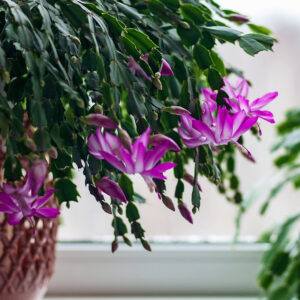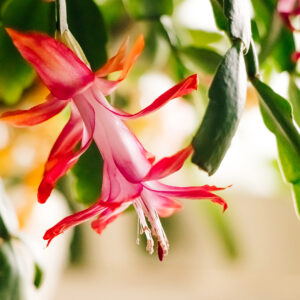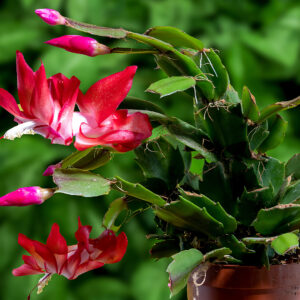What to Do with a Christmas Cactus (Schlumbergera spp.) After Christmas
The Christmas cactus, scientifically known as Schlumbergera truncata or Schlumbergera × buckleyi, is a tropical cactus that graces many homes with vibrant blooms during the holiday season. While it often steals the show at Christmas, with proper care, this beautiful plant can thrive year-round and bloom annually. Here’s a comprehensive guide to caring for your Christmas cactus after the holidays to keep it healthy and blooming for years to come.
Common Colors of Christmas Cactus Blooms
Christmas cacti come in various stunning colors, enhancing their appeal as a decorative houseplant. Here are some of the popular shades:
- Red
A classic holiday hue, red blooms are eye-catching and festive.
- Pink
Available in soft pinks to deep fuchsias, pink blooms add a gentle yet vibrant touch.
- White
Pure white or blush-toned blooms offer an elegant, understated beauty.
- Peach and Orange
These warmer tones provide a tropical feel to the plant’s appearance.
- Purple and Lavender
Though less common, purple and lavender blooms are a unique and striking addition.
Post-Holiday Care: Tidying Up and Pruning
After the blooms fade, your Christmas cactus will enter a resting period. Here’s how to give it a good start for the next growth cycle.
Remove Spent Flowers
Gently twist off any spent blooms at the base to keep the plant neat and allow it to redirect energy to new growth.
Pruning
If your plant has become leggy, you can prune it back by pinching off segments. This not only shapes the plant but also encourages bushier growth and may stimulate more blooms in the future.
Ideal Light and Temperature Conditions
To keep your Christmas cactus healthy and encourage future blooming, it’s important to provide the right light and temperature conditions.
Light
Position the plant where it can receive bright, indirect light. Avoid direct sunlight, which can burn the leaves; a north or east-facing window works well.
Temperature
Christmas cacti prefer indoor temperatures between 60-70°F. Keep them away from drafts, as well as heat sources like radiators, which can cause stress.
Adjusting Your Watering Routine
Unlike desert cacti, Christmas cacti require a moderate amount of moisture, though overwatering should be avoided.
Winter Watering
Allow the soil to dry out slightly between waterings after the plant has finished blooming. Typically, watering every 2-3 weeks is sufficient.
Spring to Fall Watering
As the plant enters its active growing season, increase watering frequency. Keep the soil evenly moist, but ensure it’s not waterlogged to prevent root rot.
Fertilizing for Healthy Growth
Fertilizing your Christmas cactus promotes strong, healthy growth and prepares it for the next blooming cycle.
Type of Fertilizer
Use a balanced, water-soluble fertilizer at half strength. A 10-10-10 NPK ratio is generally a good choice.
Fertilizing Schedule
Begin monthly fertilizing from late winter through summer, then stop feeding in early fall to allow the plant to prepare for its dormancy period and encourage blooming.
Encouraging Blooming: The Fall Dormancy Period
Christmas cacti are short-day plants, meaning they need long nights and cool temperatures to initiate blooming.
Cooler Temperatures
Around early fall, place the cactus in a room with temperatures between 50-55°F. Avoid freezing temperatures, which can damage the plant.
Darkness Cycle
Starting in mid-October, provide the cactus with 12-14 hours of uninterrupted darkness each night. Cover it with a box or place it in a dark room for 6-8 weeks to help initiate buds.
Returning to Light
Once you see buds forming, move the plant to a bright, warm location and resume normal care. Be cautious with handling, as buds can be sensitive to movement.
Repotting Your Christmas Cactus (If Needed)
Christmas cacti do best when slightly root-bound, but occasional repotting can refresh the soil and provide room for growth.
When to Repot
Repotting is best done in the spring, after the plant has finished blooming.
Pot and Soil Requirements
Choose a pot slightly larger than the current one and use a well-draining soil mix suitable for succulents or cacti. Adding peat moss or compost can help retain some moisture, aligning with the Christmas cactus’s tropical origins.
Troubleshooting Common Christmas Cactus Issues
Even with attentive care, Christmas cacti can experience problems. Here are some common issues and how to resolve them:
Drooping or Wilting Leaves
This can occur due to underwatering, overwatering, or too much direct sunlight. Make sure the soil drains well and water only when the top inch feels dry.
Bud Drop
Bud drop is often caused by temperature fluctuations, drafts, or overwatering. Try to keep conditions stable and avoid moving the plant once buds form.
Pests
Though relatively pest-resistant, Christmas cacti can sometimes attract pests like mealybugs or spider mites. Treat with a cotton swab dipped in rubbing alcohol or a gentle insecticidal soap.
Long-Term Care Summary for Christmas Cacti
Christmas cacti are wonderfully low-maintenance and can last for decades with proper care. Here’s a quick year-round guide:
- After Blooming: Remove spent blooms, prune if necessary, and reduce watering.
- Spring to Summer: Increase watering, begin monthly fertilizing, and repot if needed.
- Early Fall: Gradually reduce watering and prepare for dormancy.
- Late Fall (Dormancy): Provide 12-14 hours of darkness, cooler temperatures, and sparse watering to encourage blooming.
- Early Winter: Return the plant to bright light as buds form, and resume normal care.
Find Christmas Cacti at Strader’s Garden Center
Ready to add a Christmas cactus to your collection or need supplies for ongoing care? Strader’s Garden Center offers a variety of Christmas cacti in beautiful colors, perfect for brightening your home during the holidays and beyond. Visit Strader’s to find a Christmas cactus or pick up the essentials for long-lasting plant care. Happy gardening!















